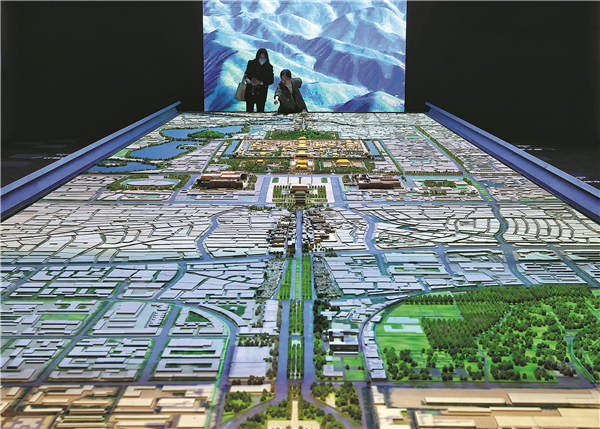

"All around the country, this is the first time that the Central Axis of Beijing is displayed in front of an audience in its entirety. For ordinary people, it is unusual to get such an impressive bird's-eye view," says the exhibition's designer Zhong Mei.
"By presenting the changes of seasons, we would like the visitors to feel what the Central Axis meant to ancient Chinese people, as well as their views of heaven, earth, humans, the universe and time."
Comprising three sections — a majestic, a cultural and an eternal Central Axis, the exhibition tells of its history, philosophy and transformation.
Zhang Wenyong, curator of the exhibition, says that the Central Axis of Beijing embodies an ideal concept of urban planning in the minds of ancient Chinese people, precisely because it reflects their appreciation of "centrality".
"By exploring ways of tracking time and identifying direction to support their everyday life and production, ancient Chinese gradually developed a value of 'respecting the central location'," Zhang says.
Some of these time-tracking devices are displayed at the exhibition, among the total 53 cultural artifacts from 17 museums and research institutes, such as a nie, a crude form of sundial from the Neolithic Age, and a jade gui, a ruler for measuring the shadows of the gnomon.
"Determining the central spot lays the basis for measuring and tracking time. The center is also in a state of equilibrium, keeping equal distances from all sides, therefore centrality is also associated with harmony," Zhang adds.
The appreciation of centrality is later extended to embody societal order, and is reflected in the urban planning of Chinese capitals, meaning that the imperial palace should be placed at the center of the capital, and other buildings are laid out along a central axis.
According to Zhang, ancient Beijing is an exemplar of these concepts, featuring a symmetrical layout, with the imperial government in front of the imperial palace and the market at the back, the Imperial Ancestral Temple on its left and the Altar of the Land and Grain on the right.
The history of Beijing's Central Axis dates back to the 13th century, when the then capital Dadu of the Yuan Dynasty (1271-1368) adopted a 3.75-km axis comprising palaces, gates and bridges.
It continued to be improved upon in the following centuries, and has evolved into a heritage structure ensemble that contains ancient imperial buildings, city management facilities, ceremonial venues, as well as historical bridges and streets.
In modern days, the imperial palaces and temples have become public venues, such as museums, parks and plazas, and more venues are built on the axis' extensions, including Beijing Daxing International Airport and Beijing Olympic Park.